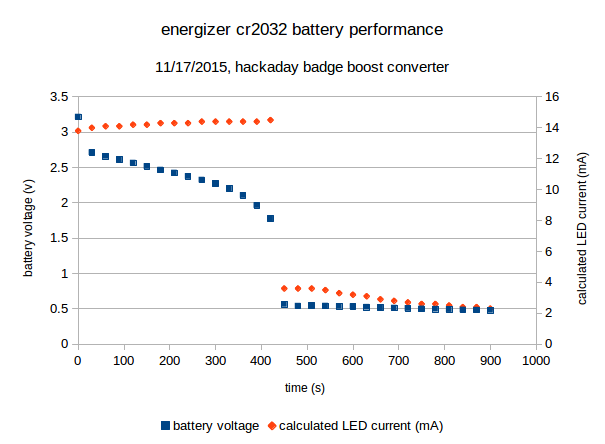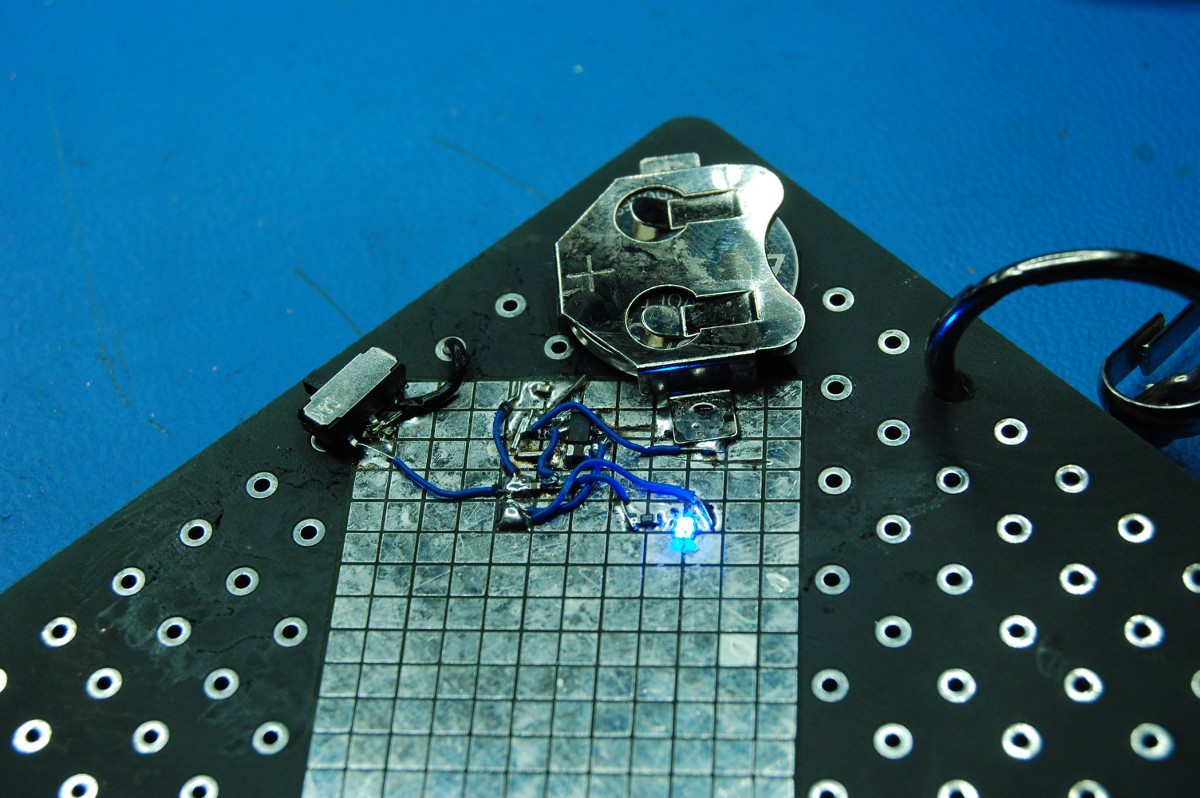News flash: the three LEDs dimmed pretty quickly. I could look at them without blinking a lot within 15 minutes or so. They did stay noticeably lit for a long time though--barely enough to navigate with through a dark room, but still pretty impressive. The battery was getting dragged down below 0.5vdc and the output also sagged a lot, so I eventually decided to desolder two of the parallel LEDs. Then, before I could do much else, I decided to make the board into a keychain, so I coated all of the exposed copper with a few layers of clear nail polish and added a soldered on hook. Makes a great accessory for a loupe, I suppose:
Anyhoo, encasing everything in clear nail polish also made it hard to measure the voltage drop across the current limiting resistor (for example), and I got tired of digging the volt meter probe under the battery to get a value there. Either way, this circuit served it's main purpose--it taught me that Building Boost Converter Circuits Is Possible.
At the [excellent and amazing] Hackaday Superconference, I used a bit of the prototyping area on the rear of my badge to recreate the circuit with a few changes:
- a blue LED (well, half of a blue/red LED) yanked from #NeuroBytes' v05 prototype stash
- a 20 ohm current limiting resistor for said LED
- a slide switch for permanent "on" operation
- less [no] nail polish
- swapped inductors to the cheaper style
Still required a few trace cuts, as the standard pads were a bit wide. Ironically, I also had to sloppily lengthen some using scraps of wire since so many parts connect to the IC. After determining that it didn't work because I'd (a) forgotten to wire up the battery positive terminal, and (b) the LED was installed backwards (who puts their green dot on the cathode??), the badge powered up (shown here de-fluxed after I got home):
Back in Mpls, it's time for some poorly instrumented tests with a fresh battery, a phone-based timer, and a voltmeter. Results, with LED current calculated based on voltage drop across the current limiting resistor:

yup, the coin cell pretty much crashed around the 4 minute mark, although the battery voltage curve is probably pretty smooth (just steep) at the "cliff". My data acquisition rate was 2 samples/minute with a fairly sizable lag between the two values, since I'm using the same multimeter for both.
Either way, it's a problem for the Blinktronicator--while the boost converter clearly works, even with a single LED driven at ~70% of its datasheet spec the circuit pulls the coin cell too low to really function. It's nice that the LED stays lit for a long time after the crash, but it's not too bright at ~2mA.
So.. more experimentation to do. I should probably wire in taps so I can chart current into the circuit and at least see how efficiently it's operating. At some point, it might make sense to just make the thing externally powered, huh?
 zakqwy
zakqwy

Discussions
Become a Hackaday.io Member
Create an account to leave a comment. Already have an account? Log In.
Interesting... So when the battery-voltage drops, the boost-converter isn't able to source as much current from it... I wonder, since the battery-voltage is almost constant until it drops, whether the LED would stay lit almost as long without the boost-converter. Also, wonder if putting a huge-capacitor before the boost-converter might allow it to suck more current out in its bursts.
Are you sure? yes | no
Both good points. One thing I've noticed--seems like people make LED "throwies" using higher voltage drop LEDs (i.e. the InGaN stuff) that are directly powered by coin cells and they stay lit for a long time. In other words, I'm pretty sure the boost converter is doing more harm than good.
I do have a nice collection of fairly large electrolytics--I'll tack one across the battery and run the tests again. I might also try with a different CR2032 brand...
Are you sure? yes | no
Oh yeah, huh... I remember seeing throwies glowing *days* if not *weeks* after being-thrown... dimly, but lit nonetheless... The brand-thing might be a good idea. I had a stockpile of 'em and noticed two distinctly different types. One seemed to have a high voltage until a load was applied, when it would drop to durn-near zero, and the other seemed to (comparatively) hold its (lower) voltage despite the load.
Heh, bet you didn't see this being such a consuming aspect of your project... I won't feel bad if you ditch it, I already feel bad enough for suggesting it ;)
Are you sure? yes | no